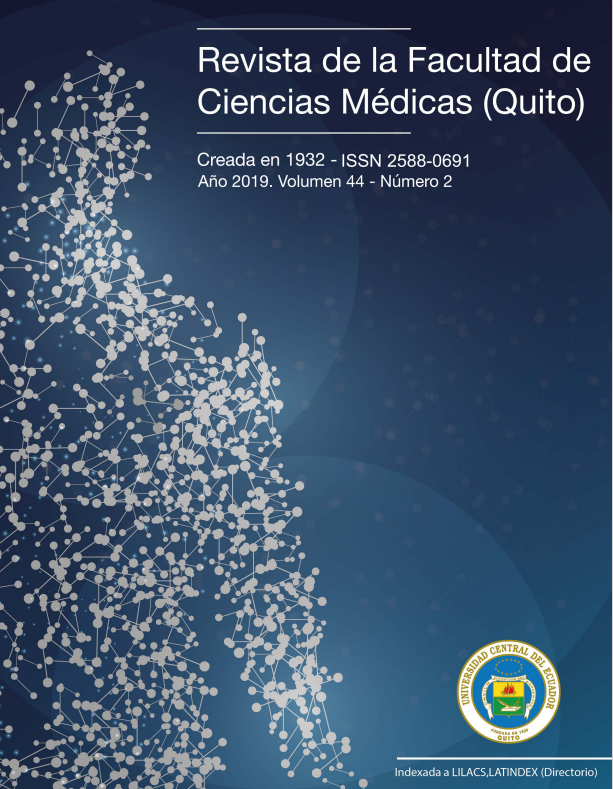Gynecomasty an underestimated reality: a case series
DOI:
https://doi.org/10.29166/rfcmq.v44i2.2692Keywords:
Gynecomastia, mastectomy, surgical woundAbstract
Background: Gynecomastia is a common but little studied benign pathology, characterized by the development of the breast in men giving it a feminine appearance, which can cause emotional stress and in turn delays or prevents the patient from going to a specialized medical consultation. Because it is not accompanied by signs of malignancy, most general practitioners consider it only an aesthetic alteration; however, the easy-to-perform surgical treatment helps the patient restore self-esteem. Cases presentation: Case series: During the period February - November 2019, there were 8 cases of gynecomastia, which corresponds to the fourth most frequent cause of surgical procedures at the General Hospital of Quevedo IESS. The age of the patients was between 17 and 30 years. The surgical treatment of choice was subcutaneous mastectomy. The mean hospital stay was 1.3 days, the suction drain removal time was between the third and fifth day, and the most frequent surgical complication (50%) was seroma. Conclusions: This series of cases demonstrates the importance of gynecomastia diagnosis, subcutaneous surgical treatment and post-surgical care to achieve bio-psycho-social balance of the individual. Although more evidence is needed, subcutaneous mastectomies that lack serious surgical complications should be performed whenever possible.
Downloads
Metrics
References
Brunicardi C, editor. Schwartz Principios de cirugía. México D.F.: McGraw-Hill Interamericana; 2015.
Barros AC, Sampaio M de C. Gynecomastia: physiopathology, evaluation and treatment. Sao Paulo Med J. 2012;130(3):187-97.
Carlson H. Approach to the patient with gynecomastia. J Clin Endocrinol Metab. 2011;96(1):15-21.
Oroz J, Pelay M, Roldán P. Ginecomastia. Tratamiento quirúrgico. Anales del Sistema Sanitario de Navarra. 2005;28 (2):109-16.
Nuñez FJ, Artola E, Cancela V. Fernández C, Palacios JR, Ginecomastia. Fisiopatología y actualización de las opciones terapéuticas. Bol Pediatr 2010; 50: 263-71.
Braunstein G, Anawalt B. Epidemiology, pathophysiology, and causes of gynecomastia. [Internet]. Holland-United Stataes: UpToDate Uptodate.com; 2019. Disponible en: https://www.uptodate.com/contents/epidemiology-pathophysiology-and-causes-of-gynecomastia
Barrantes Rodríguez K. Ginecomastia: manifestaciones, etiología, abordaje diagnóstico y tratamiento. Med Leg Costa Rica [online]. 2016;33 (1):205-10. Dipsonible
en: https://www.scielo.sa.cr/scielo.php?pid=S1409-00152016000100205&script=sci_abstract&tlng=es
Bailey SH, Guenther D, Constantine F, Rohrich RJ. Gynecomastia management: An evolution and refinement in technique at UT Southwestern Medical Center. Plast Reconstr Surg Glob Open. 2016;4 (6):e734.
Ruiz B, Raigosa M, Salvador L. Nuevo paradigma del tratamiento quirúrgico de la ginecomastia. Cir Plast Iberolatinoam. 2013;39(2):121-7.
Campos C, Hurtado L, Basurto E, Zaldivar R. Cirugía de corta estancia en sábados, domingos y días festivos, experiencia en el Servicio de Cirugía General del Hospital General de México, O.D. Cir Gen. 2012;34 (2):130-3.
Calderón W, Cabello R, Calderón D, Olguin F, Israel G. Tratamiento quirúrgico de la región mamaria masculina prominente. Cir Plast Iberolatinoam. 2010; 36(1):19-24.
Downloads
Published
Versions
- 2020-11-18 (2)
- 2019-11-29 (1)
How to Cite
Issue
Section
License
Copyright (c) 2020 José Julián Pérez Vaca, Cristina Gabriela Ríos Orozco

This work is licensed under a Creative Commons Attribution-NonCommercial-NoDerivatives 4.0 International License.











